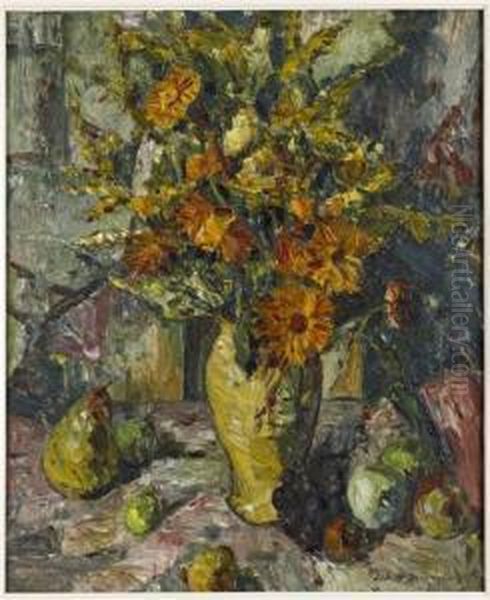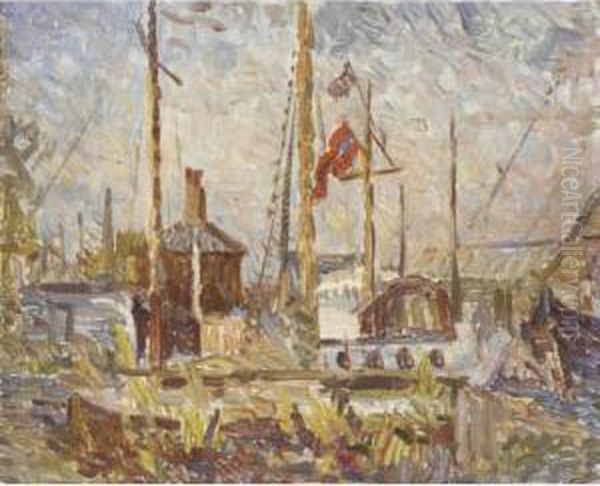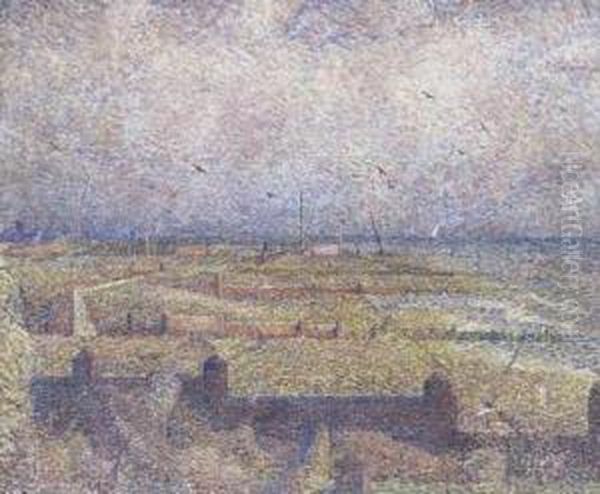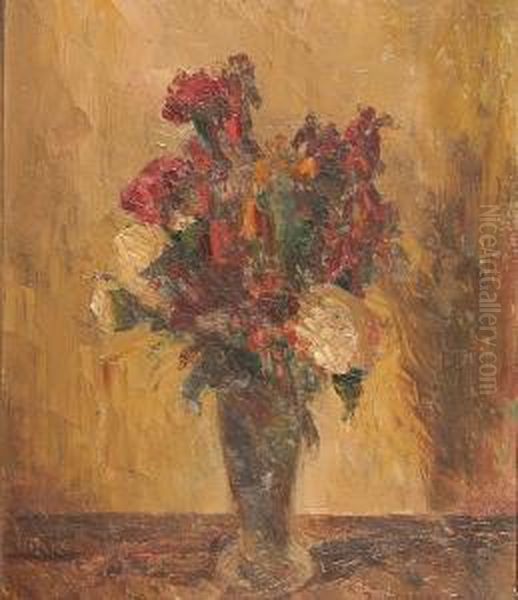Elliott Seabrooke (1886-1950) stands as a notable, if sometimes overlooked, figure in the landscape of early to mid-20th century British art. An artist of diverse talents and experiences, Seabrooke navigated the shifting currents of modernism, leaving behind a body of work characterized by thoughtful engagement with European artistic developments, a profound appreciation for landscape, and a keen intellectual approach to the principles of painting. His life, marked by artistic exploration, wartime service, and active participation in London's art societies, offers a fascinating window into the British art scene of his time.
Early Life and Artistic Foundations at the Slade
Born in Upton Park, Essex, in 1886, Elliott Seabrooke's artistic journey began in earnest at the prestigious Slade School of Fine Art in London. The Slade, at the turn of the 20th century, was a crucible of artistic talent and a vital centre for the development of modern art in Britain. Under the tutelage of influential figures such as Henry Tonks, Philip Wilson Steer, and Frederick Brown, students were grounded in rigorous draughtsmanship while also being exposed to emerging continental ideas.
Seabrooke's time at the Slade would have placed him among a generation of artists who would go on to define British modernism. Contemporaries or near-contemporaries at the Slade included luminaries such as Augustus John, Gwen John, Wyndham Lewis, Paul Nash, Stanley Spencer, David Bomberg, and Mark Gertler. This environment, buzzing with intellectual debate and artistic experimentation, undoubtedly shaped Seabrooke's early development, instilling in him a respect for tradition alongside an openness to innovation. His early artistic inclinations were also reportedly shaped by his parents, whose names he adopted for his own.
The Great War: Pacifism, Service, and Artistic Response
The outbreak of the First World War in 1914 profoundly impacted artists across Europe, and Seabrooke was no exception. A committed pacifist, he chose to serve with the British Red Cross. His dedication and bravery during his service in Italy were remarkable, leading to him being awarded the Al Valore Militare, Italy's highest military honour for gallantry. This experience of war, seen through the lens of humanitarian aid rather than combat, likely offered a unique perspective.

Subsequently, Seabrooke was appointed as an official war artist. This role, undertaken by many prominent British artists including Paul Nash, John Singer Sargent, and Wyndham Lewis, aimed to document the conflict and its impact. While specific details of Seabrooke's war art commissions from this period require further research, his involvement underscores his standing within the artistic community and his capacity to translate profound human experiences into visual form. The war years often led artists to re-evaluate their stylistic approaches, sometimes pushing them towards greater realism or, conversely, more expressive or abstract modes to convey the emotional turmoil of the era.
Artistic Style: A Synthesis of Influences
Elliott Seabrooke's mature artistic style is most closely associated with British Post-Impressionism, a broad movement that absorbed and reinterpreted the innovations of late 19th and early 20th-century French masters. The most significant and enduring influence on Seabrooke's work was undoubtedly Paul Cézanne. Cézanne's emphasis on underlying structure, the use of colour to model form, and his methodical, analytical approach to composition resonated deeply with Seabrooke. This can be seen in the way Seabrooke constructed his landscapes and still lifes, seeking a sense of solidity and permanence.
Beyond Cézanne, Seabrooke's artistic palette was enriched by other European currents. He demonstrated an interest in Pointillism, the technique pioneered by Georges Seurat and Paul Signac, which involved applying small, distinct dots of pure colour to the canvas, allowing the viewer's eye to optically mix them. This scientific approach to colour theory appealed to Seabrooke's intellectual curiosity and his desire for a "scientific painting," a term that suggests a methodical, reasoned application of artistic principles. His discussions with fellow artist Victor Pasmore regarding Seurat's rigorous use of colour further highlight this interest.
Italian Futurism, with its emphasis on dynamism, speed, and the machine age, also left its mark, though perhaps more subtly in Seabrooke's case than in the work of artists like C.R.W. Nevinson. The influence might be seen in a certain energy or a fragmented approach to form in some of his earlier Post-Impressionist works. Additionally, the lyrical qualities found in the landscapes of Jean-Baptiste-Camille Corot, a Barbizon School painter admired for his sensitive treatment of light and atmosphere, can be discerned as an antecedent to Seabrooke's own landscape paintings. There are also suggestions that he was influenced by the more abstract and whimsical qualities of Paul Klee, indicating a breadth of engagement with modernist idioms.

Seabrooke's style was not static. While early works might show a more fragmented, Post-Impressionist handling, influenced by his engagement with Cézanne and perhaps even Cubist ideas filtered through the British context, his later work is noted to have moved towards a more overtly figurative and less fragmented style, particularly after the Second World War. This evolution reflects a continued exploration and refinement of his artistic language.
Themes, Subjects, and Travels
Landscape painting formed the cornerstone of Elliott Seabrooke's oeuvre. He possessed a deep affinity for the natural world, and his travels, particularly in Holland, provided rich subject matter. His time spent living and studying in the Netherlands allowed him to immerse himself in its distinctive scenery, capturing its unique light and atmosphere. These Dutch landscapes, alongside his depictions of the English countryside, reveal his skill in conveying a sense of place and his ability to translate observed reality through a Post-Impressionist lens.
Still life was another important genre for Seabrooke. Works such as Floral Bouquet (also referred to as Flora) and other still life compositions demonstrate his Cézannesque preoccupation with form, structure, and the relationships between objects. These paintings often showcase a careful arrangement and a thoughtful application of colour, reflecting his analytical approach.
While primarily known for landscapes and still lifes, Seabrooke also engaged with figure painting, as evidenced by works like A Man Working in a Field. He also explored religious themes, with pieces such as Study of Biblical Figures indicating a broader thematic range. His involvement in theatrical performance, though less documented in terms of specific productions, suggests an interest in narrative, character, and visual presentation that may have subtly informed his pictorial work.
Representative Works: A Glimpse into Seabrooke's Vision
Several works stand out as representative of Elliott Seabrooke's artistic concerns and stylistic characteristics. Early Morning Hyde Park London likely captures the specific light and atmosphere of the urban landscape, rendered with a Post-Impressionist sensitivity to colour and form. His floral pieces, such as Floral Bouquet or Flora, would showcase his ability to imbue still life with structure and vibrant colour, echoing Cézanne's approach to the genre.

Still Life and A Man Working in a Field further exemplify his engagement with traditional genres, reinterpreted through a modern sensibility. Old Shipping in Heybridge Basin (1947), a work exhibited at the Tate, points to his continued interest in landscape and maritime scenes in his later career. His work Prose Pieces (1973, likely a posthumous titling or a later work if the date is accurate, though his death was in 1950, suggesting a possible discrepancy in the provided information or a different work) hints at a more abstract or conceptual dimension, perhaps reflecting later developments or a particular series. The previously mentioned Study of Biblical Figures indicates his exploration of more traditional, narrative subject matter.
The characteristics unifying these works would be a strong sense of composition, a thoughtful use of colour often influenced by Pointillist or Cézannesque principles, and an overall commitment to capturing the essence of the subject, whether it be the structure of a landscape, the solidity of objects in a still life, or the character of a figure.
Engagement with the Art World: Societies and Contemporaries
Elliott Seabrooke was an active participant in the London art world. He held significant positions in two of the leading progressive art societies of the day: the New English Art Club (NEAC) and The London Group (LG). He served as Vice-President of both organizations and, according to some sources, also as President of the LG. The NEAC, founded in 1886, initially provided an alternative to the Royal Academy and became a key venue for artists influenced by French Impressionism and Post-Impressionism, with members like Walter Sickert and Philip Wilson Steer. The London Group, formed in 1913 from the amalgamation of the Camden Town Group and other artists, was even more avant-garde, embracing a wider range of modernist styles. Seabrooke's leadership roles in these societies underscore his respected position among his peers.
His first solo exhibition was held at the Carfax Gallery, a significant venue known for showing modern art, including the work of artists like Spencer Gore and Harold Gilman of the Camden Town Group. This would have been an important milestone in establishing his reputation.
Seabrooke's intellectual engagement with art is further evidenced by his discussions with fellow artists. His conversations with Alastair Grieve covered topics such as the colour theories of Michel Eugène Chevreul (whose work on simultaneous contrast greatly influenced Seurat and the Neo-Impressionists), and the art of Nicolas Poussin and Paul Cézanne – artists revered for their classical structure and intellectual rigor. His dialogue with Victor Pasmore about Seurat's scientific use of colour and its inherent discipline further illuminates Seabrooke's own interest in a methodical, almost scientific approach to painting.

He also shared common artistic interests with Kenneth Martin, particularly concerning Chevreul's theories, the art of Poussin and Cézanne, and discussions related to the Eton Road School, a post-war group of artists (including Martin, Pasmore, William Coldstream, and Claude Rogers) who were associated with a more objective, observational approach to painting. Although Seabrooke was of an earlier generation, these connections show his continued relevance and engagement with evolving artistic ideas.
The fact that his works were exhibited alongside international modern masters such as Marc Chagall and Pablo Picasso in significant collections like the Tate, even if direct personal collaborations are not detailed, speaks to the calibre and recognition of his art within the broader context of 20th-century European painting.
Later Career, Wartime Contributions, and Legacy
During the Second World War, Seabrooke continued to contribute his artistic skills. He was involved in designing sketches for the Dashwood family mausoleum at West Wycombe Park, a project that remains a significant landscape feature. This commission indicates his proficiency in design and his ability to work on projects with architectural and commemorative significance.
Elliott Seabrooke passed away in 1950. His death was regarded as a significant loss to the British art world, particularly noted for his profound insights into what was termed "scientific painting"—an approach that valued intellectual understanding and methodical application of colour and compositional theory. His contributions were recognized through several memorial exhibitions held after his death, including significant shows in 1951 and 1952, which helped to consolidate his place in British art history. These exhibitions would have provided an opportunity for a comprehensive assessment of his career and his impact on the art of his time.
Conclusion: A Dedicated Modernist
Elliott Seabrooke's career charts a course of dedicated artistic inquiry. Deeply influenced by the structural innovations of Cézanne and the colour theories of the Neo-Impressionists, he forged a personal style within the framework of British Post-Impressionism. His work, primarily focused on landscape and still life, is characterized by its thoughtful composition, sensitivity to light and colour, and an underlying intellectual rigor.
As an artist, a wartime contributor, and an active member of London's leading art societies, Seabrooke played a multifaceted role in the cultural life of his era. While perhaps not as widely known today as some of his more radical contemporaries like Wyndham Lewis or David Bomberg, or those who became central figures of the Bloomsbury Group like Duncan Grant or Vanessa Bell, Elliott Seabrooke's consistent exploration of modernist principles, his dedication to "scientific painting," and his sensitive interpretations of the world around him secure his position as a significant British artist of the 20th century. His legacy lies in his thoughtful synthesis of influences and his contribution to the rich tapestry of British modern art.